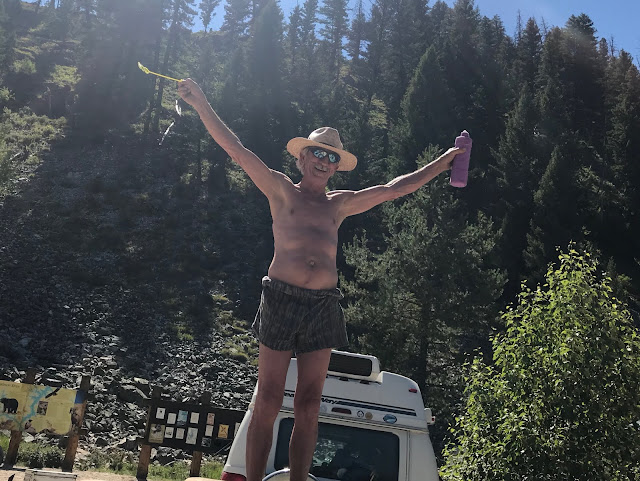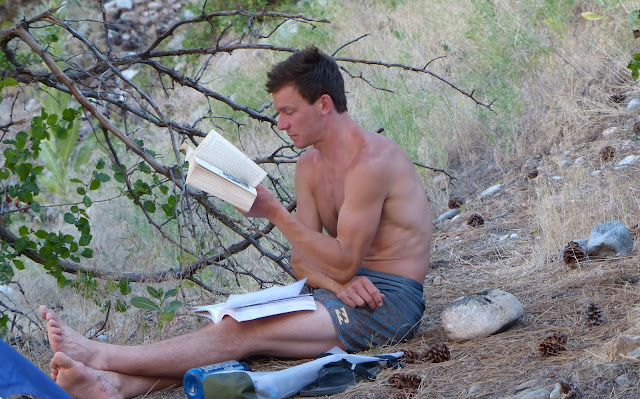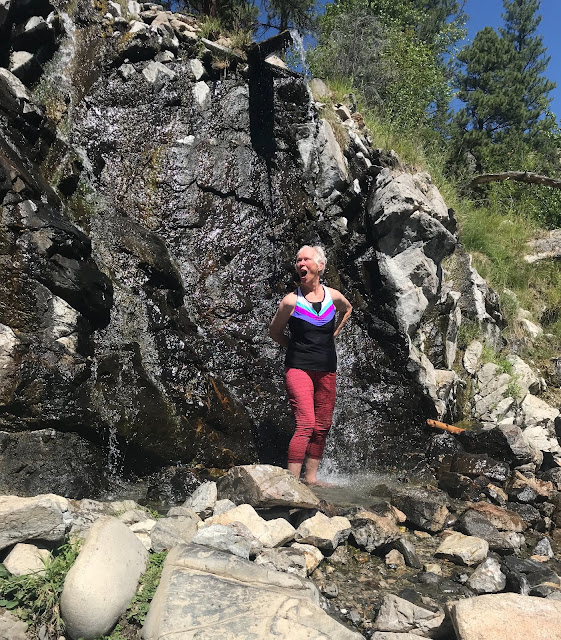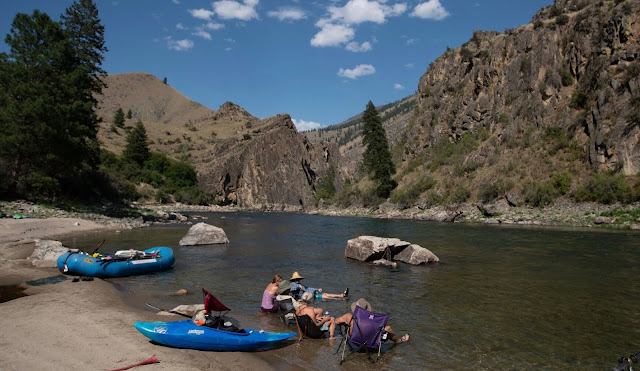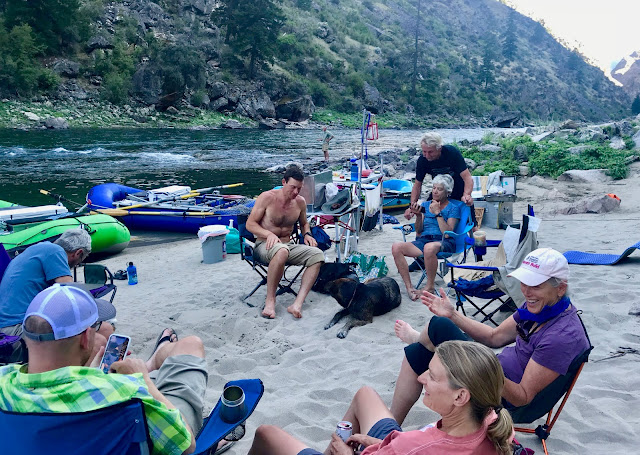A couple decades ago, PK and Chris (when he was between 8 and 11) floated the river a few springs with two other dads and their young sons. I heard stories about fishing, sleeping on tiny prickly, rocky beaches with rattlesnakes, and running one significant rapid.
No thank you.
Not once did my husband or my son mention the John Day River's fantastic scenery and fascinating geology. I'm glad I saw it. I came away with a camera load of eye candy and warm feelings induced by longtime friendships forged, in part, by shared river trips through the decades.
 |
Sue Orris nearing the top of an overlook behind one of our John Day River camps.
|

The John Day cuts through 281 miles of Central Oregon's high desert before converging with the Columbia River. One hundred and forty-seven miles of the John Day are designated Wild and Scenic, including the 72-mile stretch we navigated. It is the longest undammed river in Oregon, and one of the longest undammed rivers in the USA. On the map, our put-in at Clarno is just off the bottom (sorry) and the take-out is at the Cottonwood Bridge. In between is a serpentine river whose curves and canyons have been formed over millions of years. On the scenic scale, I give it a 7+ with the Grand Canyon being 10.
I all but gave up river trips about 14 years ago. (Links to river-related blogs follow.)
However, running rivers remains WAY high on PK's must-do-whenever-possible list. I've I agreed to one trip a year with him. This year, I'll do two. The John Day trip was the first.
The trip reminded me of what I like about river running, and what I don't.
 |
| What I really like is great scenery, and crazy geologic features such as this. |
 |
| And this jumble of folds, creases, and layering. |
 |
| The outrageous rock formations and land forms just kept coming. |
- Camping in sublime surroundings with a few good people.
- Being untethered from technology - five days and the only screen time witnessed was me using my iPhone to take photos.
- Experiencing total quiet, except for river and wildlife sounds. (Occasional 💤 noises coming from certain tents)
- Starry skies without light pollution
- If the trip is longer than a few days, getting into nature's rhythm: up at dawn, to bed when darkness descends.
- Seeing wildlife up close, even bears and snakes. (Not rattlers, though)
- Beautiful natural surroundings - of course
 |
In addition to osprey, we saw bald and golden eagles, ducks and geese, California big horn sheep, scarabs, thousands of swallows and boatloads of small mouth bass.
|
- Being self and group reliant
- Traveling with my life partner, who is happier on the river than anywhere else, except perhaps with his grandchildren.
- Photographing everything. It helps me see and appreciate.
What's irksome about river trips
- Getting ready - requires planning, packing and prep sometimes out of proportion to trip enjoyment.
- Setting up our 30-year-old old Moss tent. The damn thing never wears out!
- Lugging heavy containers up steep river banks, then down again to the raft
- Sitting for hours at a time, even with great scenery (Even in the Grand Canyon!)
- But the worst thing? Using the loo.
First somebody gets a river permit, or a wild hair, and sets in motion the mandatory planning and preparation, which I do not enjoy.
In our group of eight, Beth and Jeffrey had the wild hair and they instigated and led the trip. Permits are required, but anybody can get one. (On the John Day River, at least. Other river-permit applications are lotteries that disappoint the majority.)
Once a permit is secured, meals, transportation, shuttles, toilets, trash disposal, composting, water, clothing, etc. etc. must be organized, which requires people with better-than-average organizational skills.
I admire well organized people.
I'm not one, but I'm married to one, and at least four in our group could be in that category.
Beth is top dog. She has her shit together, always. On this trip, she used a 20+-year-old guidebook, plus experience with two previous trips on the John Day, to help us locate camps, petroglyphs, and keep track of historic events that had transpired along this stretch of river. Although a current guide lists 92 camps (!), few are obvious.
 |
| Beth may be addressing the wind on this blustery day. She is unable to organize wind and weather. |
 |
| Beth rows as Jeff, a fishing aficionado, tempts small mouth bass with lurid flies. He was not disappointed. The catch-and-release victims did not like the surprise, I'm guessing. |
Somebody gets the river trip urge. We plan. We pack. We drive close to 300 miles (on this trip) to the river. We look at all our stuff piled on the boat ramp. We balk.
Rafters are not minimalists. The packing-light conversation happens but does not result in restraint. Gotta have options. Right? We got em.
 |
The put-in for our 72-mile trip on mostly flat water began at Clarno, where a bridge crosses the river and easy access is provided by the BLM, which manages the area. According to the BLM website, one other party was putting on the river this day, but we never saw them. We had the ramp and river to ourselves
|

A fraction of our gear stacked up at the Clarno put-in.
What do we need for our river trip?
Everything! Including a toilet, water treatment (and/or clean water in containers from home), tents and sleeping bags, pads, food for five days, shelter in case of rain. We also bring a kitchen including stoves, Dutch ovens, charcoal, and every person's coffee-brewing device.
On a long-ago river trip, someone even brought a gasoline-powered blender to make margaritas. At least we got over that.
But I may be the worst offender since I packed clothes I never wore, food we never ate, and
a recently purchased solar panel to charge devices I never used.
 |
Finally we're on the river, which meanders through agricultural flat land for several miles before squeezing into scenic canyons. In mid-May the river was still flush with snowmelt from the Strawberry Mountains, where it originates. We had strong currents, gentle wind, moderate temperatures and ideal spring conditions. By the end of June, I understand, snowmelt stops, and irrigation draws down the river until li's suitable only for canoes or kayaks. Agricultural runoff was evident even with spring flows.
|
 |
| Downstream vista under a cotton tufts sky. |
 |
| What goes out of the raft must be repacked and reloaded, which requires a couple hours each day, altogether. |
 |
| Curry, rescued from the Curry County Animal Shelter, worries about his people. He doesn't want to be apart from either one, hence he traipses back and forth, benefitting from their patience and skillful rowing. A reluctant swimmer, he fell in only once. |
 |
The kitchen set up includes two three-burner stoves and three tables.The tarp was erected because we'd had heavy but brief rain earlier in the day.
|
 |
| PK spent hours every day performing catch and release operations on small mouth bass. Sometimes I rowed while he fished. |
 |
| I loved that Beth figured out where some hard-to-find petroglyphs were located and led us to them, despite our doubts. |
 |
| Who were the people who survived this harsh land without portable toilets,inflatable mattresses, and more food than they could eat? More resourceful than we are, no doubt. But it's unlikely any of them lived as long as our group of mostly sixty-somethings. |
 |
| Lichen decorates petroglyphs. |
 |
| Margaret has been rowing for at least 30 years. Greg isn't interested, but he goes along for the ride. Near the end of the trip here, I bet he's thinking about baseball. |
 |
| We saw scarab beetles in most camps. |
 | ||
Sheep in the John Day River wilderness are primarily California Big Horn sheep, which are smaller than Rocky Mountain Big Horn sheep. We saw a lot of them, including one that picked its way down an impossibly steep cliff to reach the river as we watched from our camp.
|
 |
| Lichens, natural rock hues and a bit of photo enhancement give this wall a mid-day glow. I'd love to see this in magical light - sunrise or sunset. |
 |
| A wind turbine and power towers signal we're back to civilization. We'll see hundreds of these on our way to Moro. Goodbye, John Day River. |
Posts about earlier river experiences








